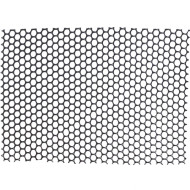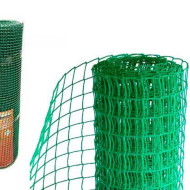The effectiveness of a nets from moles to protect plots and lawns: expert reviews
Content
What is the danger of a mole on the site
Although these animals are small and feed on insects, they are dangerous for the crops grown on the site. Moles break through passages at a shallow depth underground, in which the food they need accumulates - earthworms, woodlice, slugs, larvae, etc., up to snakes and frogs. Underground animals do not compete with humans in the food chain, they do not feed on plant crops, however:
- paving passages, they mercilessly destroy the root systems of plants, causing significant damage to the future harvest;
- earth mice and rats get to the site through the dug holes, and they feed on the grown crops.

You can understand that moles have started up on the site by the loose bumps of earth, which animals throw to the surface, equipping burrows.
Description and principle of operation of the anti-mole net
Having tried many frightening methods such as strong-smelling drugs or broken glass around the perimeter, the owners of summer cottages organize reliable protection by installing special nets. The device is simple, but very effective, does not require special knowledge during installation, but it serves for years.
By burying the net in the ground, surrounding a vegetable garden or a whole plot, it is possible to create an impassable obstacle for the animal. There are two ways to place a barrier:
- Horizontally, along a grassy lawn or flower garden. The method is suitable for cases when moles have already started on the site. Digging a passage from below to the surface and stumbling upon a net, the animal is forced to bypass the barrier in one direction or another, moving until it leaves the perimeter. As a result, it often leaves the site for good.
- Vertically, in the manner of a fence deeply buried in the ground. If there are no animals on the site yet, a vertical barrier is erected around the entire perimeter. As a result, they cannot penetrate from the outside.
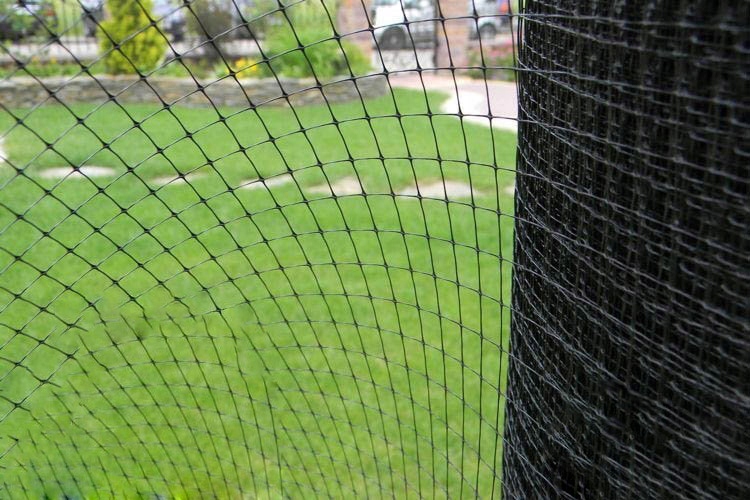
The horizontal method has pros and cons. Of the merits:
- the mesh additionally protects against soil erosion, does not allow precipitation to wash out the fertile soil;
- the slopes are strengthened on loose lands;
- the underground solid layer protects the roots of grass crops from trampling.
However, only a lawn or a flower garden can be protected in this way, since the laying of the material has to be done at a shallow depth. For ordinary vegetable gardens, the method is not suitable - digging up the earth will become impossible. True, if you build tall greenhouse beds, the horizontal laying of the mesh can be used quite successfully.
Video "How to choose a net from moles"
In this video, experts share tips for choosing reliable protection of the site and lawn from moles.
The right choice of material
There are polymer (plastic) and metal mesh coatings on the market. You need to choose a material with a small mesh size, through which the mole will not crawl, but at the same time, the holes should not be too small to let the roots of the planted crops pass.
Metal meshes are strong, but they quickly oxidize in the ground, becoming unusable. As a result, the mole will dig through it sooner or later.
Polymer varieties are more practical - they are not afraid of dampness, therefore the service life is unlimited. Two types of polymer are used:
- Polyethylene. Environmentally friendly, does not decompose in the ground, but has low strength. A mole will not be able to break it, and field mice or rats will easily gnaw it.
- Polypropylene. The technical characteristics are the same, but the strength is noticeably higher.
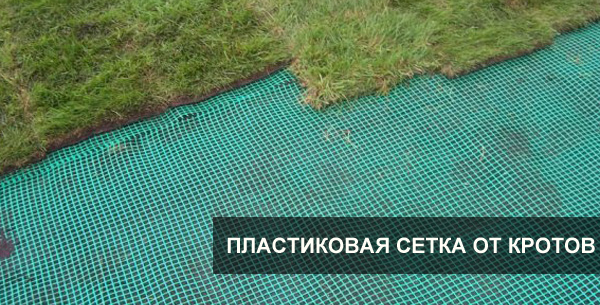
Experienced gardeners who have tried different coating options recommend choosing products from thick polypropylene with mesh sizes of 1.5–2.5 cm (the dimensions of the animals are up to 13 cm in length and 5–8 cm in width). Such material does not rot, does not break with moles. Having covered all "high" beds in greenhouses with similar nets (horizontally), it is possible to get rid of annoying underground guests for good.
Step-by-step instructions for installing the mesh
Each of the methods assumes its own technology for laying the mesh coating. There are also some subtleties, the knowledge of which will help create a real barrier.
Horizontal way
We repeat that this method is used exclusively for arranging a lawn or raised beds in a greenhouse, since the depth of the protective material is small. Laying is carried out as follows:
- The top fertile soil layer is removed to the required depth (about 15–20 cm for a flower garden or garden bed, 5–10 cm is enough for a roll lawn). The turf can be simply cut and placed in the shade by covering with a damp cloth.
- If necessary, the site is leveled.
- The mesh is laid, the edges are pressed to the ground with staples. For the area of the flower garden or lawn, the net should protrude from all four sides, otherwise the mole will calmly dig a tunnel over the protective structure. At the joints, the sheets are laid with a 10-centimeter overlap, they are also fastened with staples, without leaving even the slightest loophole for the mole.
- A removed layer of fertile soil is poured on top, which is immediately loosened, leveled and watered. Leave to soak for 2 days.
- A rolled lawn is laid on top, or lawn grass seeds are sown into the soil.
- The surface is mulched, watered abundantly.

The horizontally laid netting also protects the soil from slipping if there is a slope.
Even when laying the lawn roll, it is better to deepen the mesh into the soil rather than anchoring it to the surface itself. Moles will still dig right under the lawn, characteristic swellings will appear on the surface, into which you can accidentally fall when walking.
Vertical way
The method is more complicated, but it allows you to protect an area untouched by animals from possible invasion. Installation of the anti-mole mesh is carried out according to the following principle:
- A trench 80 cm deep is dug along the perimeter of the site (the animal's habitation hole is located at a depth of 1.5–2 m, but the foraging passages extend at the surface at a depth of 5–50 cm). A trench width of 30 cm is sufficient for the subsequent laying of the material. Dig only from the unprotected sides, the presence of a deep strip foundation under the fence or proximity to the road makes the task easier.
- The net is installed in a trench so that the edge protrudes 20 cm above the surface.
- In dense soil, the vertically installed mesh is fixed with staples, in loose soil, it is fastened with a stapler to wooden blocks. When joining two rolls, an overlap of 10 cm is required.
- They bury a trench, simultaneously ramming the ground.
- It is desirable to connect the protruding edges of the material with a fence or garden curb.
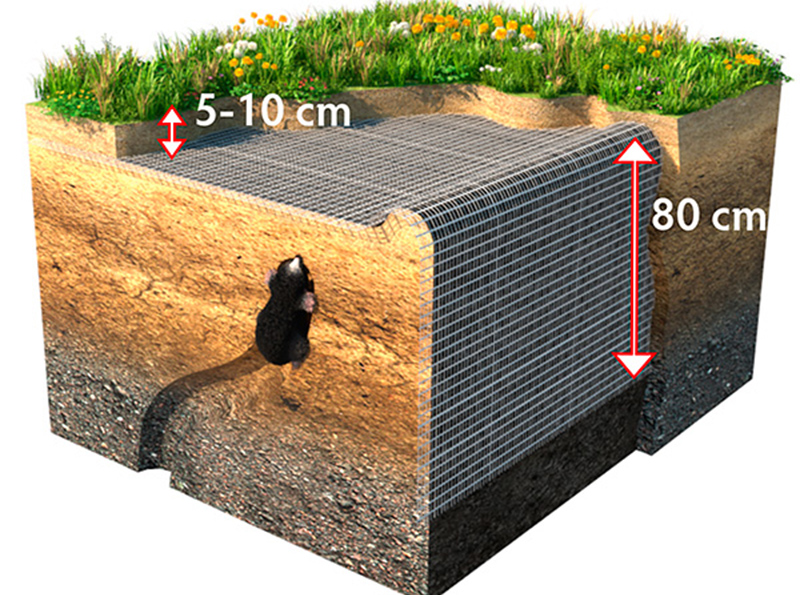
Solid option
In this case, you have to combine both of the previously described methods. One edge of the mesh is dug in vertically to a depth of 80 cm at the border of the site, then the material is pulled over the top, deepening horizontally to a depth of 10 cm in places where lawns or beds are supposed to be.
In this way, it is possible to close the site completely from uninvited guests - both from all sides and from below.
Most effective products
We recommend to our readers some brands of anti-mole nets that are popular among amateur gardeners and landscape designers.
Protect G8
The diameter of the cells is small (8x6 mm), which will protect against small vole mice. The polymer material is reinforced, withstands the pressure of the sliding soil up to 20 tons per meter. Does not rust, does not rot. Service life is about 25 years. Roll weight: 10 kg.
Protect G9
The mesh is made of polymer reinforced material. The mesh diameter is 9x9 mm. The product also holds a load of up to 20 tons per 1 meter, is not afraid of corrosion, decay. The service life of Protect G8 is up to 25 years, roll weight: 10 kg.
Syntoflex
Manufacturer - Italian company Tenax. This is a premium product: the mesh is thinner than the competition, but stronger and more flexible. The dimensions of the cells are 12x14 mm. Service life - up to 25 years.
Lawn mesh Grinda
The product of a Lithuanian company that produces tools and materials for gardeners and gardeners. Anti-mole nets are made of polyethylene, painted black. The mesh size is 9x9 mm, roll width - 1 m, length - 10 m.
Anti-mole netting SR15
Polypropylene material from a Russian manufacturer. The mesh size is 13 by 15 mm, the roll width is 1 m, and the length is 20 m. It is produced in green and blue colors, which allows using the net as a decorative fence.
- Grinda
- Russian SR15
- Syntoflex
- Protect G8
Reviews of summer residents
“Two years ago, moles entered the site, ruined the flower garden with tulips. In the same year, he set up a barrier around the perimeter of the flower bed, and also put the net in a continuous layer from below. While it is in effect, I have not recorded any new damage. "
“My husband and I wanted to lay a lawn in front of the house on the purchased plot, but neighbors warned that moles are frequent guests in this area. We decided not to risk it, bought a Sintoflex mesh, strong and reliable (according to reviews), installed it up and down. Then they just planted the grass. 2 years have passed, we have not seen any molehills. "
Anti-mole nets are a great thing to spend only once on and protect the site for decades. Many companies that offer mesh as a product, at the same time carry out all the necessary work on the installation of protection on site.

